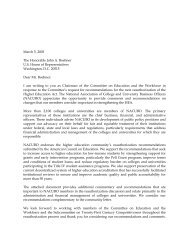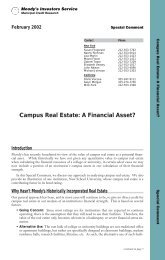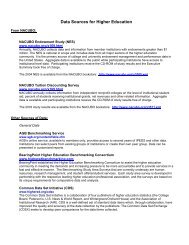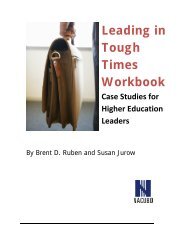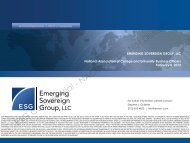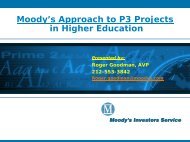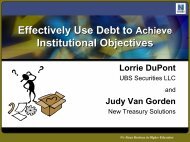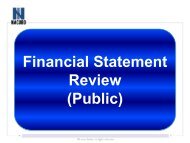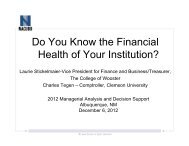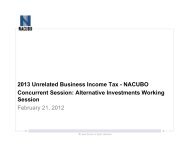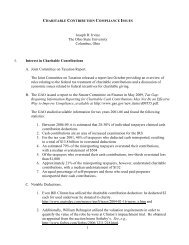Developing a Strategy to Manage Enterprisewide Risk in ... - NACUBO
Developing a Strategy to Manage Enterprisewide Risk in ... - NACUBO
Developing a Strategy to Manage Enterprisewide Risk in ... - NACUBO
Create successful ePaper yourself
Turn your PDF publications into a flip-book with our unique Google optimized e-Paper software.
Made possible through<br />
the sponsorship of<br />
PricewaterhouseCoopers<br />
DEVELOPING A<br />
STRATEGY TO MANAGE<br />
ENTERPRISEWIDE RISK<br />
IN HIGHER EDUCATION
<strong>NACUBO</strong> AND PRICEWATERHOUSECOOPERS WOULD LIKE TO THANK THE HIGHER<br />
EDUCATION LEADERS WHO CONTRIBUTED TO THIS PAPER, INCLUDING:<br />
Janice Abraham, President & Chief Executive Officer, United Educa<strong>to</strong>rs Insurance<br />
Elizabeth Cherry, Direc<strong>to</strong>r, University of Wash<strong>in</strong>g<strong>to</strong>n<br />
John Curry, Executive Vice President, Massachusetts Institute of Technology<br />
John Eldert,Vice President, Bus<strong>in</strong>ess & F<strong>in</strong>ancial Affairs, Babson College<br />
Elizabeth Huidekoper,Vice President for F<strong>in</strong>ance, Harvard University<br />
Jaimie Lewis Keith, Direc<strong>to</strong>r of Environmental & <strong>Risk</strong> <strong>Manage</strong>ment Programs, Massachusetts<br />
Institute of Technology<br />
Glenn Kl<strong>in</strong>ksiek, Direc<strong>to</strong>r of <strong>Risk</strong> <strong>Manage</strong>ment and Audit, University of Chicago<br />
Deloris Pettis-Donaldson, Direc<strong>to</strong>r of <strong>Risk</strong> <strong>Manage</strong>ment and Audit Services, Harvard<br />
University<br />
Jane Thompson, Associate Vice Chancellor, Plann<strong>in</strong>g & Analysis, University of Pittsburgh<br />
Rick Whitfield,Vice President, University of Pennsylvania
STRATEGY TO MANAGE ENTERPRISEWIDE RISK<br />
DEVELOPING A STRATEGY TO MANAGE<br />
ENTERPRISEWIDE RISK IN HIGHER EDUCATION<br />
BY DALE CASSIDY, LARRY GOLDSTEIN,<br />
SANDRA L. JOHNSON, JOHN A. MATTIE, AND JAMES E. MORLEY, JR.<br />
<strong>NACUBO</strong> and PricewaterhouseCoopers asked a group of higher education leaders <strong>to</strong> come <strong>to</strong>gether <strong>to</strong><br />
discuss the <strong>to</strong>pic of enterprisewide risk management <strong>in</strong> higher education. PricewaterhouseCoopers presented<br />
the results of its research on how risk management techniques have evolved over the past decade <strong>in</strong> the forprofit<br />
corporate sec<strong>to</strong>r.With this research and understand<strong>in</strong>g as a common framework, the assembled leaders<br />
discussed the practical implications of effective enterprisewide risk management <strong>in</strong> higher education.The focus<br />
was on:<br />
■<br />
■<br />
■<br />
■<br />
The def<strong>in</strong>ition of risk<br />
<strong>Risk</strong> “drivers” <strong>in</strong> higher education <strong>to</strong>day<br />
Implement<strong>in</strong>g a risk management program <strong>to</strong> effectively assess, manage, and moni<strong>to</strong>r risk<br />
How <strong>to</strong> proactively engage the campus community (i.e., trustees, faculty, and staff) <strong>in</strong> a more <strong>in</strong>formed<br />
dialogue regard<strong>in</strong>g enterprisewide risk management<br />
The follow<strong>in</strong>g paper presents risk management theory, examples of approaches be<strong>in</strong>g taken by the for-profit<br />
corporate sec<strong>to</strong>r, and the discussions held with higher education leaders as <strong>to</strong> how <strong>to</strong> manage risk more<br />
effectively <strong>in</strong> <strong>to</strong>day's dynamic higher education environment.<br />
We believe that college and university bus<strong>in</strong>ess officers play a vital role <strong>in</strong> the risk management agenda. Our<br />
objective for this paper is <strong>to</strong> frame the discussion that many bus<strong>in</strong>ess officers have already <strong>in</strong>itiated on<br />
campuses across the country and <strong>to</strong> move it forward.<br />
1
STRATEGY TO MANAGE ENTERPRISEWIDE RISK<br />
SECTION 1: THE DEFINITION OF RISK<br />
THE WORD RISK IS COMMONLY USED. Executives and adm<strong>in</strong>istra<strong>to</strong>rs talk about competitive risk,<br />
market risk, f<strong>in</strong>ancial risk, operat<strong>in</strong>g risk, technological risk, environmental risk, regula<strong>to</strong>ry risk,<br />
litigation risk, reputational risk, and political risk. In fact, risks are all around us. Needless <strong>to</strong> say,<br />
manag<strong>in</strong>g risks <strong>in</strong> large, complex, decentralized organizations is a significant challenge. However,<br />
before risks can be effectively managed, the organization must agree on a common def<strong>in</strong>ition of<br />
risk that is clearly unders<strong>to</strong>od throughout the organization by the board, management, and staff.<br />
Discussion and debate around risk and related controls is not a new issue. Mean<strong>in</strong>gful<br />
discussions surround<strong>in</strong>g such subjects began over ten years ago. After the Watergate revelations<br />
about illegal political contributions, legisla<strong>to</strong>rs and regula<strong>to</strong>rs turned their attention <strong>to</strong> <strong>in</strong>ternal<br />
control, consider<strong>in</strong>g the controls that perhaps should have been <strong>in</strong> place <strong>to</strong> prevent the illegal<br />
actions. One result was a study by the Treadway Commission (National Commission on<br />
Fraudulent F<strong>in</strong>ancial Report<strong>in</strong>g), which, among other recommendations, called for a common<br />
def<strong>in</strong>ition of <strong>in</strong>ternal control. In the late 1980s, the Committee of Sponsor<strong>in</strong>g Organizations<br />
(COSO) of the Treadway Commission conducted a study <strong>to</strong> def<strong>in</strong>e and further advance the<br />
understand<strong>in</strong>g of <strong>in</strong>ternal controls. COSO's report, Internal Control-Integrated Framework, was<br />
published <strong>in</strong> 1992. It offered the follow<strong>in</strong>g def<strong>in</strong>ition:<br />
Internal control is def<strong>in</strong>ed as “a process, affected by an entity's board of direc<strong>to</strong>rs,<br />
management and other personnel, designed <strong>to</strong> provide reasonable assurance regard<strong>in</strong>g the<br />
achievement of objectives <strong>in</strong> the follow<strong>in</strong>g categories: effectiveness and efficiency of<br />
operations; reliability of f<strong>in</strong>ancial report<strong>in</strong>g; and compliance with applicable laws and<br />
regulations.” 2<br />
The COSO report helped <strong>to</strong> establish a common language around controls. S<strong>in</strong>ce its issuance,<br />
risk management concepts and techniques have evolved at a quicken<strong>in</strong>g pace <strong>in</strong> the marketplace.<br />
Prior <strong>to</strong> the COSO report, risk was generally viewed <strong>in</strong> terms that reflected primarily negative<br />
outcomes. <strong>Risk</strong> management meant mak<strong>in</strong>g sure that an organization was adequately protected<br />
<strong>in</strong> the event of a catastrophe. Increas<strong>in</strong>gly <strong>in</strong> <strong>to</strong>day's environment, risk is be<strong>in</strong>g more broadly<br />
def<strong>in</strong>ed as any issue that affects an organization's ability <strong>to</strong> meet its objectives. In this light, risk<br />
management encompasses all of the operational, f<strong>in</strong>ancial, compliance, and strategic issues that an<br />
organization might encounter <strong>in</strong> its attempt <strong>to</strong> achieve its objectives.We present five types of risk<br />
on the follow<strong>in</strong>g page.<br />
2 COSO Report, Internal Control-Integrated Framework, page 9.<br />
3
STRATEGY TO MANAGE ENTERPRISEWIDE RISK<br />
THE NEW LANGUAGE OF RISK<br />
RISK IS ANY ISSUE THAT IMPACTS an organization's ability <strong>to</strong> meet its objectives. Five types of<br />
risk <strong>in</strong>clude:<br />
1) STRATEGIC RISK IS RISK THAT AFFECTS AN ORGANIZATION'S ABILITY TO ACHIEVE ITS GOALS.<br />
For example, a smaller, tuition-dependent college's strategy is <strong>to</strong> expand its enrollment base<br />
<strong>in</strong><strong>to</strong> new markets, while more effectively manag<strong>in</strong>g its f<strong>in</strong>ancial aid budget. How can the<br />
college assess and manage its risk How well does the college understand its competitive<br />
environment so that it can effectively atta<strong>in</strong> its strategic goals<br />
2) FINANCIAL RISK IS RISK THAT MAY RESULT IN A LOSS OF ASSETS. For example, a university<br />
with a his<strong>to</strong>rically conservative endowment and <strong>in</strong>vestment philosophy decides <strong>to</strong> <strong>in</strong>vest more<br />
heavily <strong>in</strong> foreign <strong>in</strong>vestments and private equity funds with multiple <strong>in</strong>vestment managers,<br />
while enter<strong>in</strong>g <strong>in</strong><strong>to</strong> new hedg<strong>in</strong>g arrangements. How does the university manage the potential<br />
market and credit risk that may negatively impact the university's <strong>in</strong>vestments Will the market<br />
perform as expected<br />
3) OPERATIONAL RISK IS RISK THAT AFFECTS AN ONGOING MANAGEMENT PROCESS. For example,<br />
a university has recently implemented new adm<strong>in</strong>istrative systems (e.g., general ledger, payroll<br />
and human resources, student systems). The systems implementation <strong>in</strong>volved changes <strong>to</strong><br />
bus<strong>in</strong>ess processes with respect <strong>to</strong> transaction process<strong>in</strong>g by decentralized department<br />
adm<strong>in</strong>istra<strong>to</strong>rs and staff. How does the university manage the risk that its staff are not<br />
effectively process<strong>in</strong>g and moni<strong>to</strong>r<strong>in</strong>g transactions <strong>in</strong> the new environment How can it put<br />
the new system <strong>in</strong><strong>to</strong> operation most effectively<br />
4) COMPLIANCE RISK IS RISK THAT AFFECTS COMPLIANCE WITH EXTERNALLY IMPOSED LAWS<br />
AND REGULATIONS AS WELL AS WITH INTERNALLY IMPOSED POLICIES AND PROCEDURES<br />
CONCERNING SAFETY, CONFLICT OF INTEREST, AND THE LIKE. For example, an Academic<br />
Medical Center (AMC) with significant research and cl<strong>in</strong>ical activities is responsible for<br />
comply<strong>in</strong>g with an ever-chang<strong>in</strong>g body of federal rules and regulations and their<br />
<strong>in</strong>terpretation. How does the AMC ensure that its pr<strong>in</strong>cipal <strong>in</strong>vestiga<strong>to</strong>rs, physicians, and staff<br />
are aware of and comply<strong>in</strong>g with rules and regulations<br />
5) REPUTATIONAL RISK IS RISK THAT AFFECTS AN ORGANIZATION'S REPUTATION, BRAND, OR<br />
BOTH. (NOTE THAT THIS RISK MAY RESULT FROM AN ORGANIZATION'S FAILURE TO EFFECTIVELY<br />
MANAGE ANY OR ALL OF THE OTHER RISK TYPES; IT INVOLVES EXTERNAL PERCEPTION). For example,<br />
a prestigious university is establish<strong>in</strong>g several satellite campuses <strong>in</strong> Europe.The campuses will be<br />
4
STRATEGY TO MANAGE ENTERPRISEWIDE RISK<br />
f<strong>in</strong>anced with donor funds as well as with funds received from the local country.The university's<br />
faculty will be teach<strong>in</strong>g on the campuses. How does the university manage the risk that<br />
<strong>in</strong>effective management of its new global venture might tarnish its prestigious brand<br />
ALL SUCCESSFUL ENTERPRISES TAKE RISKS. Shareholders and lenders entrust their capital <strong>to</strong><br />
publicly-held companies and their boards because they seek a higher return than could be<br />
achieved by a less risky <strong>in</strong>vestment, such as government securities. Inves<strong>to</strong>rs expect boards and<br />
management <strong>to</strong> demonstrate entrepreneurship and dynamic behavior—take risks, <strong>in</strong> other<br />
words—<strong>to</strong> achieve these higher returns.<br />
Similarly, donors, staff, and other stakeholders who <strong>in</strong>vest their time, talents, and resources <strong>in</strong><br />
colleges and universities do so <strong>to</strong> further the objectives of educat<strong>in</strong>g students, study<strong>in</strong>g the<br />
unknown, and attack<strong>in</strong>g ethical and moral dilemmas.Their <strong>in</strong>vestment implies a desire <strong>to</strong> see the<br />
<strong>in</strong>stitution f<strong>in</strong>d <strong>in</strong>novative and more effective ways <strong>to</strong> achieve these objectives—that is, take risks.<br />
Goals that are worthy of the struggle <strong>to</strong> accomplish them cannot be achieved without tak<strong>in</strong>g<br />
some risk. In personal <strong>in</strong>vest<strong>in</strong>g, for example, the more risk one takes, the greater the potential<br />
reward—and the greater the potential loss.This is why <strong>in</strong>ves<strong>to</strong>rs are encouraged <strong>to</strong> diversify their<br />
portfolios; diversification among a variety of <strong>in</strong>dustries and geographies spreads the risk of a<br />
significant loss.<br />
Companies take calculated risks <strong>in</strong> much the same way. Consider the biotechnology field,<br />
where only 7.5 percent of good ideas make it through the typical 11-year development cycle <strong>to</strong><br />
become marketable drugs. 3 Biotechnology firms must take enough risk <strong>to</strong> earn the reward that a<br />
successful new drug will br<strong>in</strong>g—an amaz<strong>in</strong>g 85 percent gross marg<strong>in</strong> over the life of the patent—<br />
but not so much risk that all development money will be spent on any one idea. 4<br />
In the higher education environment, decid<strong>in</strong>g how best <strong>to</strong> <strong>in</strong>vest <strong>in</strong> e-bus<strong>in</strong>ess might be a<br />
good example. Dot.coms began <strong>to</strong> approach colleges and universities a few years ago about a<br />
wide variety of opportunities for partnerships and alliances. Many vendors wanted <strong>to</strong> sell their<br />
e-bus<strong>in</strong>ess solutions <strong>to</strong> <strong>in</strong>stitutions. Most <strong>in</strong>stitutions recognized the need <strong>to</strong> participate <strong>in</strong><br />
e-bus<strong>in</strong>ess <strong>to</strong> stay competitive, but how should an <strong>in</strong>stitution choose from among the offers This<br />
situation could have been approached as a risk management exercise. One downside risk was the<br />
potential embarrassment of partner<strong>in</strong>g with a dot.com that failed <strong>to</strong> deliver on its promise of high<br />
quality.The <strong>in</strong>stitution would want <strong>to</strong> take action <strong>to</strong> mitigate this risk and <strong>to</strong> <strong>in</strong>crease the chances<br />
of a good outcome.<br />
3 Puschaver, Lee and Robert G. Eccles,“In Pursuit of the Upside:The New Opportunity <strong>in</strong> <strong>Risk</strong> <strong>Manage</strong>ment,” Lead<strong>in</strong>g Th<strong>in</strong>k<strong>in</strong>g on Issues<br />
of <strong>Risk</strong>, published by PricewaterhouseCoopers, page 4.<br />
4 Ibid, page 4.<br />
5
STRATEGY TO MANAGE ENTERPRISEWIDE RISK<br />
The chief risk officer at a large f<strong>in</strong>ancial services company recognized the upside and downside<br />
potential of risk, when he offered this def<strong>in</strong>ition: “<strong>Risk</strong> is about bad th<strong>in</strong>gs that do happen and<br />
good th<strong>in</strong>gs that don't happen.” 5 It is important <strong>to</strong> manage both for the downside and for the<br />
upside <strong>to</strong> enhance the possibility that good th<strong>in</strong>gs will occur. Manag<strong>in</strong>g risk on the upside is an<br />
offensive action taken by management <strong>to</strong> <strong>in</strong>crease the possibility of success, and often revenues.<br />
Manag<strong>in</strong>g risk on the downside is a defensive action <strong>to</strong> reduce the possibility of adverse<br />
developments that may cost money or cause embarrassment.<br />
THE RISK CONTINUUM<br />
RISK CAN BE DEPICTED ON A CONTINUUM<br />
from manag<strong>in</strong>g hazards <strong>to</strong> see<strong>in</strong>g risk as an<br />
opportunity, as depicted <strong>in</strong> the diagram below. Although functional emphasis and management<br />
boundaries are <strong>in</strong>herently flexible,“risk as hazard” represents the his<strong>to</strong>ric perspective of managers<br />
who are responsible for f<strong>in</strong>ancial and compliance activities—specifically the controller, <strong>in</strong>ternal<br />
Diagram 1: THE BUSINESS RISK CONTINUUM 6<br />
Compliance<br />
and Prevention<br />
Operat<strong>in</strong>g<br />
Performance<br />
Strategic<br />
Initiatives<br />
Opportunity<br />
Uncerta<strong>in</strong>ty<br />
Hazard<br />
<strong>Manage</strong>ment Responsibilities<br />
(e.g., Controller, Internal Audi<strong>to</strong>r, CFO)<br />
5 Ibid, page 8.<br />
6 Ibid, page 3.<br />
6
STRATEGY TO MANAGE ENTERPRISEWIDE RISK<br />
Diagram 2: THE MARKET CONTINUUM<br />
Crisis <strong>Manage</strong>ment<br />
and Compliance<br />
■<br />
■<br />
Bus<strong>in</strong>ess Cont<strong>in</strong>uity<br />
Protection<br />
■<br />
■<br />
■<br />
■<br />
■<br />
■<br />
■<br />
Improved returns through<br />
value-based management<br />
■ Enhanc<strong>in</strong>g capital allocation<br />
Protect<strong>in</strong>g reputation<br />
Achiev<strong>in</strong>g best practices<br />
Understand<strong>in</strong>g and evaluat<strong>in</strong>g strategic risks<br />
Understand<strong>in</strong>g full range of risks fac<strong>in</strong>g organizations <strong>to</strong>day<br />
Avoid<strong>in</strong>g personal liability (the personal fear fac<strong>to</strong>r)<br />
Compliance with corporate and governance standards<br />
(fiduciary responsibility)<br />
The crisis of other organizations<br />
The crisis of one’s own organization<br />
Stakeholder Value<br />
Enhancement<br />
Hazard Uncerta<strong>in</strong>ty Opportunity<br />
audi<strong>to</strong>r, <strong>in</strong>surance risk manager, and compliance officer. “<strong>Risk</strong> as uncerta<strong>in</strong>ty” is a govern<strong>in</strong>g<br />
perspective of the CFO and l<strong>in</strong>e managers who are responsible for operations. This group<br />
searches for best practices and reacts <strong>to</strong> the control failures of their competi<strong>to</strong>rs by seek<strong>in</strong>g <strong>to</strong><br />
prevent them from happen<strong>in</strong>g <strong>in</strong> their own operations. “<strong>Risk</strong> as opportunity” often reflects the<br />
outlook of senior management and the plann<strong>in</strong>g staff, who largely address the outside elements of<br />
risk. Opportunity, hazard, and uncerta<strong>in</strong>ty—successful long-term risk management <strong>in</strong>volves a<br />
balanc<strong>in</strong>g of all three.<br />
HIGHER EDUCATION'S VIEW OF RISK MANAGEMENT<br />
HOW DOES HIGHER EDUCATION VIEW risk management Some colleges and universities equate<br />
risk management with crisis management, or they associate it with compliance risk. Some <strong>in</strong>stitutions<br />
focus on “manag<strong>in</strong>g the downside,” rather than see<strong>in</strong>g risk as an opportunity. Some equate risk<br />
management with m<strong>in</strong>imiz<strong>in</strong>g hazards, particularly those result<strong>in</strong>g from violations of university<br />
policies or of external laws and regulations. There is noth<strong>in</strong>g wrong with these views of risk<br />
management. But there is much <strong>to</strong> be ga<strong>in</strong>ed by add<strong>in</strong>g a new view—one that also aims <strong>to</strong> manage<br />
the upside of risk and <strong>to</strong> see the many opportunities it presents.A balanced view of risk is best, one<br />
that tries <strong>to</strong> m<strong>in</strong>imize hazards, <strong>in</strong>fluence and control uncerta<strong>in</strong>ties, and manage opportunities.<br />
7
STRATEGY TO MANAGE ENTERPRISEWIDE RISK<br />
SELF-ASSESSMENT 1:<br />
WHERE IS YOUR INSTITUTION ON THE RISK CONTINUUM<br />
Where does your <strong>in</strong>stitution stand on the risk cont<strong>in</strong>uum <strong>in</strong> Diagram 2 on page 7 In<br />
general, the further up the cont<strong>in</strong>uum, the better for the <strong>in</strong>stitution. The questions <strong>in</strong> the<br />
follow<strong>in</strong>g table might help you determ<strong>in</strong>e your <strong>in</strong>stitution's position on the risk cont<strong>in</strong>uum.<br />
Is your <strong>in</strong>stitution focused primarily on manag<strong>in</strong>g the hazards of crises and be<strong>in</strong>g <strong>in</strong><br />
compliance with laws and regulations If so, its concerns are likely <strong>to</strong> center on:<br />
■<br />
■<br />
■<br />
Its own crises or those of its peers<br />
Compliance matters<br />
Avoid<strong>in</strong>g personal liability<br />
Is your <strong>in</strong>stitution focused on controll<strong>in</strong>g uncerta<strong>in</strong>ties as well as on crisis management and<br />
compliance If so, its concerns are likely <strong>to</strong> center on:<br />
■<br />
■<br />
■<br />
■<br />
Understand<strong>in</strong>g the full range of risks it faces<br />
Understand<strong>in</strong>g and evaluat<strong>in</strong>g strategic risks<br />
Achiev<strong>in</strong>g best practices<br />
Protect<strong>in</strong>g reputation<br />
Does your <strong>in</strong>stitution view risk as an opportunity <strong>to</strong> enhance stakeholder value (<strong>in</strong> addition <strong>to</strong><br />
crisis management, compliance, and controll<strong>in</strong>g uncerta<strong>in</strong>ties) If so, its concerns are likely <strong>to</strong><br />
<strong>in</strong>clude:<br />
■<br />
■<br />
Enhanc<strong>in</strong>g capital or funds allocation<br />
Improved returns through value-based management<br />
Ideally, an <strong>in</strong>stitution should be do<strong>in</strong>g all of these—manag<strong>in</strong>g hazards, comply<strong>in</strong>g with laws<br />
and regulations, controll<strong>in</strong>g uncerta<strong>in</strong>ties, and view<strong>in</strong>g risk as an opportunity <strong>to</strong> enhance<br />
stakeholder value.<br />
8
STRATEGY TO MANAGE ENTERPRISEWIDE RISK<br />
SECTION II: THE DRIVERS OF RISK<br />
WHERE DOES RISK COME FROM One of the first steps <strong>in</strong> any risk management assessment is <strong>to</strong><br />
consider the drivers of risk. Broadly stated, the drivers of risk are the fac<strong>to</strong>rs that <strong>in</strong>troduce risk<br />
<strong>in</strong><strong>to</strong> an environment. Before risk management solutions can be developed, the current drivers of<br />
risk must be identified and then evaluated. <strong>Risk</strong> drivers can be categorized as operational,<br />
strategic, compliance, f<strong>in</strong>ancial, and reputational. Each of these drivers directly affects the<br />
organization's revenues.They can be dynamically modeled <strong>to</strong> simulate the effect of each risk so<br />
that the organization develops a better understand<strong>in</strong>g of its risk drivers and result<strong>in</strong>g cash flows.<br />
For example, the British government recently announced that it plans <strong>to</strong> develop a bus<strong>in</strong>ess<br />
plan for a new <strong>in</strong>ternational “e-university.” The plan will be developed through the Higher<br />
Education Fund<strong>in</strong>g Council <strong>in</strong> Great Brita<strong>in</strong>. The bus<strong>in</strong>ess plan might consider such fac<strong>to</strong>rs as<br />
recruit<strong>in</strong>g faculty and students <strong>in</strong>ternationally, accept<strong>in</strong>g tuition payments <strong>in</strong> different currencies,<br />
and cop<strong>in</strong>g with global economic cycles. In the bus<strong>in</strong>ess plan, the council might want <strong>to</strong> model<br />
cash flows under various scenarios <strong>to</strong> better gauge the f<strong>in</strong>ancial risks of launch<strong>in</strong>g an e-university.<br />
IN TODAY'S OPERATING ENVIRONMENT, many drivers contribute <strong>to</strong> higher education's risk<br />
profile. The tables on this page and the next were developed by two groups of higher education<br />
leaders who met <strong>to</strong> discuss emerg<strong>in</strong>g risk management concepts.The first table (Table A below)<br />
focuses on strategic risk drivers, while the second (Table B on page 10) features operational and<br />
compliance risk drivers. Each table depicts the drivers of risk <strong>in</strong> the left-hand column, the primary<br />
stakeholders who are responsible and more directly impacted for each risk <strong>in</strong> the center column<br />
and, <strong>in</strong> the right hand column, the relative rank of each risk as high, medium, or low. The risks<br />
have been arranged by “heat” level, beg<strong>in</strong>n<strong>in</strong>g with the “hottest” drivers of risk.<br />
Table A: STRATEGIC DRIVERS OF RISK IN HIGHER EDUCATION<br />
RISK DRIVER STAKEHOLDERS “HEAT” LEVEL<br />
Emerg<strong>in</strong>g Educational Delivery Systems<br />
xxx<br />
Inability of Governance Processes <strong>to</strong> Support<br />
Strategic Objectives<br />
Increas<strong>in</strong>g Opportunities <strong>to</strong> Leverage<br />
Intellectual Capital<br />
Excess Physical Capability<br />
Quality of Academic Program<br />
Increas<strong>in</strong>g Cus<strong>to</strong>mer Expectations (e.g., f<strong>in</strong>ancial<br />
aid, student life, access, capacity)<br />
Students, Faculty, Executive <strong>Manage</strong>ment, Staff,<br />
Accredit<strong>in</strong>g Agencies<br />
Trustees, Executive <strong>Manage</strong>ment, Faculty<br />
Executive <strong>Manage</strong>ment and Faculty<br />
Trustees, Executive <strong>Manage</strong>ment, Donors<br />
Students, Faculty, Executive <strong>Manage</strong>ment<br />
Students, Parents<br />
H<br />
H<br />
H<br />
H<br />
M<br />
M<br />
9
STRATEGY TO MANAGE ENTERPRISEWIDE RISK<br />
Table B: OPERATIONAL AND COMPLIANCE RISK DRIVERS IN HIGHER EDUCATION<br />
RISK DRIVER STAKEHOLDERS “HEAT” LEVEL<br />
New Technologies<br />
xxx<br />
Reimbursement and F<strong>in</strong>ancial Issues Fac<strong>in</strong>g<br />
Academic Medical Centers<br />
Increased Regula<strong>to</strong>ry Scrut<strong>in</strong>y and<br />
Accountability<br />
Research and Intellectual Property<br />
(e.g., ownership of courseware)<br />
Human Resource <strong>Manage</strong>ment<br />
(e.g., attract<strong>in</strong>g, reta<strong>in</strong><strong>in</strong>g, tra<strong>in</strong><strong>in</strong>g)<br />
Unionization<br />
(e.g., graduate schools and faculty)<br />
Decentralized Responsibility<br />
xxx<br />
Security, Internet Access, Electronic Records<br />
xxx<br />
New Construction and Deferred Ma<strong>in</strong>tenance<br />
xxx<br />
New Bus<strong>in</strong>ess Creation<br />
(e.g., subsidiaries, <strong>in</strong>ternational operations)<br />
Increased Competition<br />
(e.g., for faculty, students, gifts, and research)<br />
Student Behavior and Community<br />
xxx<br />
Contract<strong>in</strong>g and Related Processes<br />
xxx<br />
Endowment <strong>Manage</strong>ment<br />
xxx<br />
Trustees, Executive <strong>Manage</strong>ment, Staff<br />
(for selected issues)<br />
Dean of Medic<strong>in</strong>e, Cl<strong>in</strong>ical Faculty, Regula<strong>to</strong>rs,<br />
Hospital Boards,Trustees, Research Community<br />
Trustees, Executive <strong>Manage</strong>ment, Internal Audit,<br />
Public<br />
Executive <strong>Manage</strong>ment, Research<br />
Human Resource <strong>Manage</strong>ment, Unions, Staff<br />
Human Resource <strong>Manage</strong>ment, Staff<br />
Staff, Faculty, Audi<strong>to</strong>rs<br />
Students, Executive <strong>Manage</strong>ment, Faculty, Staff<br />
Real Estate Office, Donors, Executive<br />
<strong>Manage</strong>ment<br />
Staff, Faculty<br />
Trustees, Executive <strong>Manage</strong>ment, Faculty<br />
Alumni, Parents, Students, Faculty, President<br />
At<strong>to</strong>rneys and Executive <strong>Manage</strong>ment<br />
Trustees, Staff, Alumni, Other Donors<br />
H<br />
H<br />
H<br />
H<br />
H<br />
H<br />
H<br />
M<br />
M<br />
M<br />
M<br />
M<br />
L <strong>to</strong> M<br />
L <strong>to</strong> M<br />
Note that the first group gave the hottest ranks <strong>to</strong> the strategic risk challenges. In a second<br />
group's view, the hottest risk drivers arose from operational challenges such as compliance issues,<br />
technology, and so forth.<br />
The two tables <strong>in</strong>dicate that many challenges confront higher education, which was a<br />
conclusion that did not come as a surprise <strong>to</strong> any of the higher education leaders assembled that<br />
day. What can be done <strong>to</strong> solve them Are there any lessons we can learn by apply<strong>in</strong>g risk<br />
management models How do we as bus<strong>in</strong>ess officers prepare our organizations <strong>to</strong> deal with the<br />
challenges<br />
10
STRATEGY TO MANAGE ENTERPRISEWIDE RISK<br />
SELF-ASSESSMENT 2:<br />
WHAT RISK DRIVERS ARE AFFECTING YOUR INSTITUTION<br />
Before it is ready <strong>to</strong> implement a risk management program, an <strong>in</strong>stitution should<br />
understand and evaluate the full range of risks it faces. Consider, for example, the risk drivers<br />
identified <strong>in</strong> Tables A and B on pages n<strong>in</strong>e and ten.Are these risks affect<strong>in</strong>g your <strong>in</strong>stitution<br />
Most <strong>in</strong>stitutions are aware of the f<strong>in</strong>ancial and compliance risks they face. Many <strong>in</strong>stitutions<br />
also have taken the next step, which is develop<strong>in</strong>g plans <strong>to</strong> address these risks. It is much<br />
harder <strong>to</strong> develop plans for strategic and reputational risks. Has your <strong>in</strong>stitution considered<br />
its strategic and reputational risks<br />
11
STRATEGY TO MANAGE ENTERPRISEWIDE RISK<br />
SECTION III: IMPLEMENTING A RISK MANAGEMENT PLAN<br />
ONCE AN INSTITUTION’S LEADERS UNDERSTAND how risk is def<strong>in</strong>ed and identify the full<br />
range of risks they face, they should develop a risk management plan. Learn<strong>in</strong>g how other<br />
organizations manage risk can be helpful. Research <strong>in</strong>dicates that certa<strong>in</strong> organizational models<br />
are more effective than others. It also <strong>in</strong>dicates that organizations with effective risk management<br />
programs evolve over time. At each stage, they become better at manag<strong>in</strong>g risk. Most of the<br />
research PricewaterhouseCoopers has conducted <strong>in</strong>volves the for-profit corporate world, <strong>in</strong><br />
which risk management techniques have undergone a significant evolution over the past ten<br />
years.The more effective models exist <strong>in</strong> those organizations where risk management has evolved<br />
from a backroom function <strong>to</strong> a CEO and boardroom function.<br />
Today’s organizations approach risk management <strong>in</strong> ways that can be broadly categorized <strong>in</strong><strong>to</strong><br />
five levels:<br />
■<br />
■<br />
■<br />
■<br />
Level I organizations see little value <strong>in</strong> proactive risk management. Other than <strong>in</strong>surance risk<br />
management, there are few formal risk management programs <strong>in</strong> place <strong>in</strong> Level I<br />
organizations.They tend <strong>to</strong> implement risk control mechanisms only when unmanaged risk<br />
turns <strong>in</strong><strong>to</strong> a problem or crisis.<br />
In Level II organizations, there is general awareness about risk management and some<br />
conceptual appreciation for its value <strong>in</strong> assur<strong>in</strong>g that not all uncerta<strong>in</strong>ties become problems.<br />
Although most bus<strong>in</strong>ess units do someth<strong>in</strong>g <strong>to</strong> moni<strong>to</strong>r their risks, there are no centralized<br />
processes, no systematic moni<strong>to</strong>r<strong>in</strong>g, and no def<strong>in</strong>ed accountability for risk management.<br />
Level III organizations are aware of risk management and they have set up some mechanisms<br />
<strong>to</strong> moni<strong>to</strong>r risks. For example, Level III organizations may have an <strong>in</strong>ternal audit function.<br />
Internal audit may design audits with a risk focus. It may also promote self-assessments of risk,<br />
often us<strong>in</strong>g a checklist.<br />
In Level IV, a broader risk management position is created <strong>to</strong> review “hot” spots, assist <strong>in</strong> risk<br />
assessment with<strong>in</strong> the bus<strong>in</strong>ess units, and keep score. Organizations that reach this level<br />
consider both qualitative and quantitative fac<strong>to</strong>rs.While checklists are used, the cus<strong>to</strong>mization<br />
of these <strong>to</strong>ols and the strength of the entire risk management program rely heavily on the<br />
knowledge, judgment, and effective span of <strong>in</strong>fluence of the chief risk officer (i.e., the<br />
corporate officer who is responsible for risk management).<br />
13
STRATEGY TO MANAGE ENTERPRISEWIDE RISK<br />
■ By Level V, the highest level, risk management has fully evolved from a back office function <strong>to</strong><br />
a CEO-level concern. In a Level V organization, the CEO believes that risk management<br />
should be imbedded <strong>in</strong> every part of the organization. He or she sponsors the risk management<br />
program.Work<strong>in</strong>g with the senior leadership team, a risk manager designs processes, forms, and<br />
tra<strong>in</strong><strong>in</strong>g. With the ongo<strong>in</strong>g assistance of the risk manager, each bus<strong>in</strong>ess unit designs its own<br />
risk mitigation plan. The bus<strong>in</strong>ess units track their progress aga<strong>in</strong>st action plans. Tra<strong>in</strong><strong>in</strong>g<br />
programs are <strong>in</strong> place.The goal is a balanced scorecard performance appraisal with cont<strong>in</strong>uous<br />
improvement. Tools may <strong>in</strong>clude <strong>in</strong>formation on databases, surveys or questionnaires, po<strong>in</strong>t<br />
scor<strong>in</strong>g or weight<strong>in</strong>g, au<strong>to</strong>mated forms and processes, and the moni<strong>to</strong>r<strong>in</strong>g of action plans.<br />
Internal audit moni<strong>to</strong>rs the risk management program <strong>to</strong> assure that the process is <strong>in</strong> place and<br />
work<strong>in</strong>g effectively.<br />
THE FIVE ORGANIZATIONAL MODELS IN ACTION<br />
TO SEE HOW EACH OF THE ABOVE models would actually work, let us consider how a particular<br />
issue might be viewed. Us<strong>in</strong>g employee turnover as the issue, let’s exam<strong>in</strong>e how the organization<br />
at each level might view risk:<br />
■<br />
In Level I and Level II organizations, the questions be<strong>in</strong>g asked and the issues on which<br />
attention is focused would likely be:<br />
■<br />
If key staff members leave, how exposed will the organization be<br />
■ What processes do we have <strong>in</strong> place <strong>to</strong> mitigate this risk and <strong>to</strong> fill positions when key staff<br />
members leave<br />
■ In Level III organizations, the issues would more likely be:<br />
■ What benefits exist <strong>to</strong> ma<strong>in</strong>ta<strong>in</strong> employee satisfaction<br />
■ How are we sure that we are competitive <strong>in</strong> the marketplace<br />
■ What steps must we take <strong>to</strong> assess and moni<strong>to</strong>r employee satisfaction<br />
■<br />
In Level IV and V organizations, there is an appreciation for turn<strong>in</strong>g risk <strong>in</strong><strong>to</strong> opportunity by<br />
ask<strong>in</strong>g and solv<strong>in</strong>g such questions as:<br />
■<br />
■<br />
What can we do <strong>to</strong> create a program that will attract and reta<strong>in</strong> the best and the brightest<br />
Could we adopt employee ideas, provide scholarships, and actively advertise that we are the best<br />
place <strong>to</strong> work<br />
14
STRATEGY TO MANAGE ENTERPRISEWIDE RISK<br />
SELF-ASSESSMENT 3:<br />
WHICH LEVEL HAS YOUR INSTITUTION ATTAINED<br />
Consider the italicized questions on page 14 us<strong>in</strong>g the hypothetical issue of employee<br />
turnover. How would your <strong>in</strong>stitution view this issue How would you categorize your<br />
<strong>in</strong>stitution As a Level I Level II Level III, or IV, or V To help your <strong>in</strong>stitution evolve <strong>to</strong><br />
<strong>in</strong>creas<strong>in</strong>gly higher levels, consider the eight key elements of an effective risk management<br />
organization that beg<strong>in</strong> below.<br />
EIGHT KEY ELEMENTS<br />
AS NOTED EARLIER, RISK MANAGEMENT organizations evolve over time, gradually mov<strong>in</strong>g from<br />
Level I <strong>to</strong> Level V—assum<strong>in</strong>g all goes well at each level. It becomes <strong>in</strong>creas<strong>in</strong>gly important for the<br />
organization <strong>to</strong> have the follow<strong>in</strong>g eight key elements <strong>in</strong> place. In fact, unless it has these eight key<br />
elements <strong>in</strong> place, it is unlikely that the organization will become truly effective at manag<strong>in</strong>g risk.<br />
1) ACCEPTANCE OF A RISK MANAGEMENT FRAMEWORK AS THE FOCAL POINT AND THE COMMON<br />
LANGUAGE: Everyone <strong>in</strong> the organization (<strong>in</strong>clud<strong>in</strong>g the board) needs <strong>to</strong> be educated about the<br />
risk management <strong>in</strong>itiative; they must understand the process. Furthermore, they need <strong>to</strong><br />
become familiar with the new language of risk.<br />
2) SENIOR MANAGEMENT COMMITMENT: Top management must embrace the need for an<br />
evolution <strong>to</strong> an <strong>in</strong>tegrated risk management framework. <strong>Manage</strong>ment must set the proper <strong>to</strong>ne<br />
at the <strong>to</strong>p for risk management <strong>to</strong> work.<br />
3) RISK MANAGEMENT OWNER: A chief risk officer, or another member of management, must be<br />
designated for an appropriate period of time <strong>to</strong> implement the program.The chief risk officer<br />
would work with each bus<strong>in</strong>ess unit, leverag<strong>in</strong>g its knowledge and that of its operat<strong>in</strong>g l<strong>in</strong>e<br />
<strong>in</strong>dividuals.<br />
4) COMMUNICATION: The compell<strong>in</strong>g need for an evolution <strong>to</strong> an <strong>in</strong>tegrated risk management<br />
framework must be communicated throughout the organization. The communication needs<br />
are much broader than the traditional def<strong>in</strong>ition of risk. Earlier, we def<strong>in</strong>ed risk as any issue<br />
that could impact an organization’s ability <strong>to</strong> achieve its objectives.This def<strong>in</strong>ition assumes that<br />
the organization’s objectives have been clearly def<strong>in</strong>ed and that they have been effectively and<br />
widely communicated.<br />
5) TRAINING: Staff must be mobilized with effective tra<strong>in</strong><strong>in</strong>g.<br />
15
STRATEGY TO MANAGE ENTERPRISEWIDE RISK<br />
6) REINFORCEMENT THROUGH HUMAN RESOURCE MECHANISMS: Human resource mechanisms<br />
must be developed that establish accountability and reward effective behavior. The balanced<br />
scorecard is a method of compensat<strong>in</strong>g people, a way <strong>to</strong> reward those who display the right<br />
behavior. (Some employers are compensat<strong>in</strong>g staff for good risk management skills.They also<br />
are look<strong>in</strong>g for these skills when recruit<strong>in</strong>g.)<br />
7) PROCESS: There must be a risk management process <strong>in</strong> place.The drivers of risk may change,<br />
but the process need not change.The risk management process must identify opportunities for<br />
susta<strong>in</strong>able competitive advantage. It also must permit timely corrective action or action <strong>to</strong><br />
mitigate the risk.<br />
8) MONITORING BY INTERNAL AUDIT: Internal audit should play a key role. The <strong>in</strong>ternal audit<br />
department should be viewed and empowered as an agent <strong>to</strong> assess and improve risk<br />
management practices.<br />
16
STRATEGY TO MANAGE ENTERPRISEWIDE RISK<br />
SECTION IV. ADVANCING THE RISK MANAGEMENT AGENDA FURTHER<br />
IN OUR MEETING WITH HIGHER EDUCATION leaders we discussed the key question: How can<br />
higher education <strong>in</strong>stitutions, given their culture and traditions, become more proactive <strong>in</strong><br />
discuss<strong>in</strong>g and <strong>in</strong>itiat<strong>in</strong>g change designed <strong>to</strong> enhance their risk management and control structure<br />
The table below summarizes the challenges, along with some potential solutions, higher<br />
education leaders saw <strong>in</strong> engag<strong>in</strong>g the campus community <strong>to</strong> improve bus<strong>in</strong>ess risk management<br />
processes and structure. Follow<strong>in</strong>g Table C, we consider several ideas—<strong>in</strong>volv<strong>in</strong>g trustees and<br />
audit committees, for example, and manag<strong>in</strong>g the opportunities <strong>to</strong> advance the risk management<br />
agenda—<strong>in</strong> greater depth.We also present several case studies.<br />
Table C: RISK MANAGEMENT CHALLENGES AND SOLUTIONS<br />
CHALLENGE<br />
SOLUTION<br />
Market<strong>in</strong>g risk - <strong>Risk</strong> has a negative<br />
connotation. It is not viewed as be<strong>in</strong>g tied<br />
<strong>to</strong> strategic objectives; it is not a core<br />
<strong>in</strong>terest.<br />
Measur<strong>in</strong>g risk - It is difficult <strong>to</strong> quantify<br />
risk on anyth<strong>in</strong>g but a relative scale.<br />
F<strong>in</strong>d new ways <strong>to</strong> talk about risk. Convene groups of <strong>in</strong>stitutional<br />
experts <strong>to</strong> discuss strategic and compliance risks. Def<strong>in</strong>e the<br />
reputational and f<strong>in</strong>ancial impacts. Clearly identify risks associated<br />
with major <strong>in</strong>itiatives already underway where the <strong>in</strong>stitution cannot<br />
“afford <strong>to</strong> fail.”<br />
Develop a model with appropriate qualitative and quantitative<br />
outcomes and <strong>in</strong>dica<strong>to</strong>rs (e.g., benchmarks).<br />
Identify<strong>in</strong>g “champions” - F<strong>in</strong>d<strong>in</strong>g<br />
champions with the authority and<br />
credibility <strong>to</strong> educate management and<br />
faculty is key.<br />
Appeal <strong>to</strong> trustees’ experience and f<strong>in</strong>d a champion on the board.<br />
Also, f<strong>in</strong>d sponsors at the faculty/department level.<br />
Culture - The higher education culture is<br />
decentralized, slow <strong>to</strong> change, reactive, and<br />
analytical.<br />
Reward cooperation.Tie risk <strong>to</strong> strategic objectives <strong>in</strong> the plann<strong>in</strong>g<br />
process. Offer solutions, <strong>to</strong>ols, tra<strong>in</strong><strong>in</strong>g, and resources. Build action <strong>in</strong><strong>to</strong><br />
consensus.<br />
Def<strong>in</strong><strong>in</strong>g accountability - F<strong>in</strong>d<strong>in</strong>g ways <strong>to</strong><br />
motivate people <strong>to</strong> take more<br />
responsibility for risk is key. <strong>Risk</strong> is <strong>to</strong>o<br />
often viewed as someone else’s problem.<br />
Create <strong>in</strong>centives for manag<strong>in</strong>g risk. <strong>Manage</strong> the opportunities and<br />
take advantage of lessons learned from crises.The objective is <strong>to</strong><br />
demonstrate that effective risk management can m<strong>in</strong>imize future<br />
crises. Designate a “risk management” change agent.<br />
17
STRATEGY TO MANAGE ENTERPRISEWIDE RISK<br />
INVOLVE TRUSTEES<br />
BOARDS OF TRUSTEES ALREADY PLAY a significant role <strong>in</strong> the development of an <strong>in</strong>stitution's<br />
risk management and control structure.They can very effectively promote and support the right<br />
“conscience” or “<strong>to</strong>ne from the <strong>to</strong>p” that an effective enterprisewide risk management<br />
program needs.<br />
The Blue Ribbon Committee on Improv<strong>in</strong>g the Effectiveness of Corporate Audit<br />
Committees (the Committee) was created <strong>in</strong> Oc<strong>to</strong>ber 1998 by the New York S<strong>to</strong>ck Exchange<br />
(NYSE) and National Association of Securities Dealers (NASD).The Committee was created <strong>in</strong><br />
response <strong>to</strong> concerns expressed by the Securities and Exchange Commission (SEC) on how best<br />
<strong>to</strong> improve board oversight of the f<strong>in</strong>ancial report<strong>in</strong>g process of public companies. The<br />
Committee issued its recommendations <strong>in</strong> early 1999. By December 1999, self-regulat<strong>in</strong>g bodies<br />
(the NYSE, NASD,American S<strong>to</strong>ck Exchange) as well as the SEC and the American Institute of<br />
Certified Public Accountants (AICPA) Audit<strong>in</strong>g Standards Board had issued rules implement<strong>in</strong>g<br />
the Blue Ribbon Committee's recommendations.<br />
The rules cover corporate governance, <strong>in</strong>clud<strong>in</strong>g audit committee <strong>in</strong>dependence,<br />
qualifications, and composition. They say that audit committees should carry out appropriate<br />
activities <strong>to</strong> moni<strong>to</strong>r organizationwide risk assessment processes <strong>in</strong> publicly held companies.<br />
While the rules apply only <strong>to</strong> publicly held companies, higher education <strong>in</strong>stitutions should<br />
seriously consider adopt<strong>in</strong>g them as best practices. One reason is that higher education audit<br />
committees <strong>in</strong>clude executives who are responsible for comply<strong>in</strong>g with the Blue Ribbon<br />
Committee's recommendations <strong>in</strong> the private sec<strong>to</strong>r. They will be <strong>in</strong>cl<strong>in</strong>ed <strong>to</strong> expect similar<br />
standards on campus.<br />
The second reason is that it is better <strong>to</strong> be proactive.We suggest that audit committees should<br />
assume a broader role sooner rather than later <strong>to</strong> moni<strong>to</strong>r risk. Audit committees should def<strong>in</strong>e<br />
the risk culture of an educational <strong>in</strong>stitution, support organizational goals <strong>to</strong> assess and manage<br />
risk, and ensure that <strong>in</strong>ternal audit moni<strong>to</strong>rs processes <strong>to</strong> mitigate risk.<br />
18
STRATEGY TO MANAGE ENTERPRISEWIDE RISK<br />
SELF-ASSESSMENT 4:<br />
IS YOUR AUDIT COMMITTEE ADVANCING THE RISK MANAGEMENT AGENDA<br />
To ensure that they are play<strong>in</strong>g an appropriate role <strong>in</strong> support<strong>in</strong>g enterprisewide risk<br />
management and control, as well as fulfill<strong>in</strong>g their own fiduciary responsibilities, audit<br />
committees should ask the follow<strong>in</strong>g questions:<br />
■<br />
■<br />
■<br />
■<br />
■<br />
Does my <strong>in</strong>stitution have an effective process for identify<strong>in</strong>g risk Does the process<br />
<strong>in</strong>clude an assessment of the probability of risk and its potential impact on the <strong>in</strong>stitution<br />
Who owns this process at my <strong>in</strong>stitution<br />
Is this committee comfortable that enterprisewide risk is assessed, managed,<br />
and moni<strong>to</strong>red What type of report do we review <strong>to</strong> support this process<br />
Has my <strong>in</strong>stitution assessed the risks for its most critical strategic objectives Are<br />
management controls <strong>in</strong> place <strong>to</strong> mitigate these risks<br />
If management controls are not <strong>in</strong> place, what type of assurance does this committee have<br />
that actions will be taken <strong>to</strong> put such controls <strong>in</strong> place What type of follow-up report<strong>in</strong>g<br />
do we review <strong>to</strong> ensure that corrective action has taken place<br />
Do my <strong>in</strong>stitution's bus<strong>in</strong>ess processes support organized decisions and actions Does my<br />
<strong>in</strong>stitution conduct tra<strong>in</strong><strong>in</strong>g for risk and control<br />
■<br />
Is my <strong>in</strong>stitution's <strong>in</strong>ternal audit plan designed <strong>to</strong> effectively moni<strong>to</strong>r management's<br />
processes <strong>to</strong> manage risk, or is it relied upon <strong>to</strong> identify risk<br />
MANAGE THE OPPORTUNITIES<br />
THE HIGHER EDUCATION LEADERS ASSEMBLED by <strong>NACUBO</strong> and PricewaterhouseCoopers<br />
agreed that the current environment with its competitive, compliance, technological, and<br />
adm<strong>in</strong>istrative challenges presents an opportune time <strong>to</strong> discuss bus<strong>in</strong>ess risk concepts more<br />
broadly with<strong>in</strong> the campus community. Almost every <strong>in</strong>stitution is engaged <strong>in</strong> some k<strong>in</strong>d of<br />
<strong>in</strong>itiative that <strong>in</strong>troduces more risk. Consider, for example, the scenarios on the next page.<br />
19
STRATEGY TO MANAGE ENTERPRISEWIDE RISK<br />
■<br />
Institutions should be alert <strong>to</strong> the w<strong>in</strong>dows of opportunity that might already exist <strong>to</strong> further<br />
the risk management agenda. For example, it might be appropriate <strong>to</strong> <strong>in</strong>itiate a risk<br />
management discussion around an ERP systems implementation. Despite the <strong>in</strong>herent risks of<br />
such an <strong>in</strong>itiative, the upside potential for achiev<strong>in</strong>g better decision-mak<strong>in</strong>g capabilities is<br />
substantial. Decid<strong>in</strong>g how best <strong>to</strong> proactively manage systems risk is an ideal platform from<br />
which <strong>to</strong> build a broader risk management discussion.<br />
■ If an <strong>in</strong>stitution were consider<strong>in</strong>g implement<strong>in</strong>g an e-bus<strong>in</strong>ess <strong>in</strong>itiative, it would be a<br />
wonderful opportunity <strong>to</strong> engage <strong>in</strong> a discussion of enterprisewide risk management. E-<br />
bus<strong>in</strong>ess <strong>in</strong>itiatives present broad elements of strategic (e.g., distance learn<strong>in</strong>g, <strong>in</strong>tellectual<br />
property transfer), compliance (e.g., tax and legal), and operational (e.g., process control,<br />
security, and performance) risk.The upside potential for e-bus<strong>in</strong>ess solutions cont<strong>in</strong>ues <strong>to</strong> be<br />
substantial.<br />
■<br />
■<br />
■<br />
News s<strong>to</strong>ries from neighbor<strong>in</strong>g <strong>in</strong>stitutions, or <strong>in</strong>formal <strong>in</strong>ternal surveys, can be used <strong>to</strong><br />
galvanize action <strong>to</strong> proactively identify and manage risk on an <strong>in</strong>stitution's campus. Perhaps,<br />
for example, the federal government has issued a new regulation about hazardous waste. An<br />
adm<strong>in</strong>istra<strong>to</strong>r might want <strong>to</strong> make some calls <strong>to</strong> f<strong>in</strong>d out how peer <strong>in</strong>stitutions plan <strong>to</strong> comply<br />
with it. Then the adm<strong>in</strong>istra<strong>to</strong>r might beg<strong>in</strong> <strong>in</strong>ternal discussions about appropriate solutions<br />
for his/her own campus.<br />
If bus<strong>in</strong>ess processes are changed, perhaps <strong>to</strong> more effectively capture cost sav<strong>in</strong>gs from new<br />
systems, controls <strong>to</strong> mitigate risk (e.g., f<strong>in</strong>ancial, compliance, operational) should be imbedded<br />
<strong>in</strong><strong>to</strong> the enhanced processes. Aga<strong>in</strong>, the goal is <strong>to</strong> be proactive; take advantage of change <strong>to</strong><br />
raise awareness about risk and enhance its management.<br />
External and <strong>in</strong>ternal audi<strong>to</strong>rs can help <strong>in</strong>itiate the discussion. Internal audi<strong>to</strong>rs have already<br />
served as catalysts <strong>to</strong> raise the awareness level of risk.They are th<strong>in</strong>k<strong>in</strong>g about risk <strong>in</strong> new ways<br />
and expand<strong>in</strong>g their role <strong>to</strong> moni<strong>to</strong>r it. External audi<strong>to</strong>rs can assist by mak<strong>in</strong>g sure that the<br />
discussion <strong>in</strong>cludes a full range of risks from operational <strong>to</strong> compliance <strong>to</strong> strategic. <strong>Risk</strong><br />
management impacts not just the numbers but also brand, competitiveness, and strategy.<br />
CASE STUDIES<br />
MOST COLLEGES AND UNIVERSITIES TODAY focus primarily on f<strong>in</strong>ancial and compliance risk<br />
and on build<strong>in</strong>g effective compliance programs. A few are try<strong>in</strong>g <strong>to</strong> take the risk management<br />
agenda forward <strong>to</strong> the next level.<br />
20
STRATEGY TO MANAGE ENTERPRISEWIDE RISK<br />
Some <strong>in</strong>stitutions are us<strong>in</strong>g compliance <strong>in</strong>itiatives <strong>to</strong> advance risk management. Two recent<br />
articles <strong>in</strong> the <strong>NACUBO</strong> Bus<strong>in</strong>ess Officer discussed how <strong>to</strong> establish a compliance program.The<br />
first article, “The Compliance Umbrella,” 7 suggests that an ethics and compliance program for<br />
higher education should have the follow<strong>in</strong>g six components:<br />
1) A compliance officer<br />
2) Written codes of ethics and of conduct<br />
3) Employee tra<strong>in</strong><strong>in</strong>g and communications<br />
4) An <strong>in</strong>dependent report<strong>in</strong>g mechanism, such as a hotl<strong>in</strong>e or a helpl<strong>in</strong>e, as well as<br />
communications<br />
5) Moni<strong>to</strong>r<strong>in</strong>g and risk assessment<br />
6) Corrective action plans<br />
The second article, “A Model Operat<strong>in</strong>g Process,” 8 suggests that once the <strong>in</strong>frastructure has<br />
been established the operat<strong>in</strong>g process should beg<strong>in</strong>, <strong>in</strong>clud<strong>in</strong>g as the first order of bus<strong>in</strong>ess, a risk<br />
assessment. Then for the problem areas identified <strong>in</strong> the broad-based risk assessment, the<br />
university should establish the six components of an effective compliance program that are noted<br />
above, <strong>in</strong>clud<strong>in</strong>g tra<strong>in</strong><strong>in</strong>g, communications, moni<strong>to</strong>r<strong>in</strong>g, and corrective action.<br />
ONE ONGOING INITIATIVE THAT COULD<br />
be considered an example of enterprisewide risk<br />
management is at the University of Pennsylvania. The long his<strong>to</strong>ry of crime <strong>in</strong> some<br />
neighborhoods adjacent <strong>to</strong> its campus was identified as a risk, which must be mitigated if Penn<br />
was <strong>to</strong> rema<strong>in</strong> among the elite universities <strong>in</strong> the nation. In 1995, a bold five-year program was<br />
put <strong>in</strong> place by the university's new leadership.The goals were:<br />
■ Enhanced public education <strong>in</strong> University City, a 250-block area around Penn<br />
■ Cleaner and safer neighborhoods<br />
■<br />
Enhanced commercial amenities <strong>to</strong> improve convenience and quality of life<br />
■ Us<strong>in</strong>g the university's buy<strong>in</strong>g power and <strong>in</strong>tellectual assets <strong>to</strong> facilitate job creation <strong>in</strong><br />
University City<br />
■ Aggressive promotion of Penn's neighborhoods as places for new faculty and<br />
staff <strong>to</strong> live<br />
7 Barbara E.Walsh, James A. Moran, and Gerald J. McDougall,“The Compliance Umbrella,” <strong>NACUBO</strong> Bus<strong>in</strong>ess Officer, January 2000.<br />
8 Barbara E.Walsh, James A. Moran, and Gerald J. McDougall,“A Model Operat<strong>in</strong>g Process,” <strong>NACUBO</strong> Bus<strong>in</strong>ess Officer, March 2000.<br />
21
STRATEGY TO MANAGE ENTERPRISEWIDE RISK<br />
Under the leadership of its president and executive vice president (EVP), the University of<br />
Pennsylvania is driv<strong>in</strong>g the program forward.The university is devot<strong>in</strong>g significant resources and<br />
time <strong>to</strong> the local community <strong>to</strong> promote revitalization. For example, Penn has encouraged home<br />
ownership by offer<strong>in</strong>g $15,000 <strong>to</strong>ward a mortgage for any university employee who will purchase<br />
a home <strong>in</strong> designated neighborhoods. The EVP chairs the University City District, the area<br />
where Penn, neighborhood bus<strong>in</strong>esses, hospitals, Drexel University, and the University of the<br />
Sciences <strong>in</strong> Philadelphia have agreed <strong>to</strong> target better market<strong>in</strong>g, street clean<strong>in</strong>g, safety patrols, and<br />
bus service. The University of Pennsylvania pays $2.25 million of the District's $3.9 million<br />
annual budget. 9<br />
ALIGNING WITH THE MARKETPLACE<br />
PRICEWATERHOUSECOOPERS' EXPERIENCE OVER the past several years re<strong>in</strong>forces the higher<br />
education marketplace's read<strong>in</strong>ess <strong>to</strong> view risk concepts <strong>in</strong> a new way and verifies that a broader<br />
risk consciousness is grow<strong>in</strong>g. For example, utiliz<strong>in</strong>g higher education risk <strong>to</strong>ols and<br />
methodologies, PricewaterhouseCoopers has:<br />
■<br />
■<br />
Utilized a Web-based survey <strong>to</strong> assess the risk culture and highlight hot risk areas need<strong>in</strong>g<br />
attention on several campuses<br />
Reviewed compliance programs of academic medical centers<br />
■ Assisted <strong>in</strong> develop<strong>in</strong>g universitywide risk management and compliance structures<br />
■<br />
■<br />
Verified the data publicized on several universities’ web sites for <strong>in</strong>tegrity and accuracy<br />
Developed risk assessments as part of our <strong>in</strong>ternal audit assistance at several<br />
universities<br />
9 Van Der Werf, Mart<strong>in</strong>,“A Vice President from the Bus<strong>in</strong>ess World Br<strong>in</strong>gs a New Bot<strong>to</strong>m L<strong>in</strong>e <strong>to</strong> Penn,” The Chronicle of Higher Education,<br />
September 3, 1999.<br />
22
STRATEGY TO MANAGE ENTERPRISEWIDE RISK<br />
SUMMARY<br />
HOW LONG WILL IT TAKE FOR EFFECTIVE RISK management programs <strong>to</strong> become a regular part<br />
of higher education's <strong>in</strong>ternal control arsenal Some have said,“Def<strong>in</strong><strong>in</strong>g risk is not so much the<br />
problem.” It is once you beg<strong>in</strong> <strong>to</strong> realize and discuss what it is go<strong>in</strong>g <strong>to</strong> take <strong>to</strong> solve it, that there<br />
is a tendency <strong>to</strong> be frozen <strong>in</strong> place—transfixed by the enormity of the task. Still others ma<strong>in</strong>ta<strong>in</strong><br />
that higher education has already come a long way, not<strong>in</strong>g: “A few years ago, we were build<strong>in</strong>g<br />
controls on a process. Now we are build<strong>in</strong>g risk management <strong>in</strong><strong>to</strong> a process.”We are discuss<strong>in</strong>g<br />
these <strong>to</strong>pics openly <strong>in</strong> an <strong>in</strong>formed way.”<br />
In terms of enterprisewide risk management, where is your <strong>in</strong>stitution <strong>to</strong>day Where is it head<strong>in</strong>g How can<br />
you help <strong>to</strong> advance the pace of change<br />
❖<br />
23
ABOUT PRICEWATERHOUSECOOPERS<br />
PricewaterhouseCoopers (www.pwcglobal.com) is the world's largest professional services<br />
organization. Draw<strong>in</strong>g on the knowledge and skills of more than 150,000 people <strong>in</strong> 150<br />
countries, we help our clients solve complex bus<strong>in</strong>ess problems and measurably enhance their<br />
ability <strong>to</strong> build value, manage risk and improve performance <strong>in</strong> an Internet-enabled world.<br />
PricewaterhouseCoopers refers <strong>to</strong> the member firms of the worldwide PricewaterhouseCoopers<br />
organization.<br />
ABOUT <strong>NACUBO</strong><br />
<strong>NACUBO</strong> (www.nacubo.org) is a nonprofit professional organization represent<strong>in</strong>g chief<br />
adm<strong>in</strong>istrative and f<strong>in</strong>ancial officers at more than 2,100 colleges and universities across the<br />
country. Over two-thirds of all <strong>in</strong>stitutions of higher learn<strong>in</strong>g <strong>in</strong> the United States are members<br />
of <strong>NACUBO</strong>. <strong>NACUBO</strong>'s mission is <strong>to</strong> promote sound management and f<strong>in</strong>ancial practices at<br />
colleges and universities.<br />
<strong>NACUBO</strong>'s members are nonprofit and for-profit organizations located <strong>in</strong> the United States and<br />
abroad . . . all are committed <strong>to</strong> excellence <strong>in</strong> higher education f<strong>in</strong>ance and adm<strong>in</strong>istration.<br />
<strong>NACUBO</strong>, founded <strong>in</strong> 1962, is governed by a board of direc<strong>to</strong>rs composed of leaders <strong>in</strong> higher<br />
education f<strong>in</strong>ancial management from around the country.<br />
<strong>NACUBO</strong> has a professional staff of approximately 55 persons, skilled <strong>in</strong> f<strong>in</strong>ance, management,<br />
and federal issues applicable <strong>to</strong> the field of higher education.<br />
ABOUT THE AUTHORS<br />
John A. Mattie is the partner <strong>in</strong> charge of PricewaterhouseCoopers’ risk management services for<br />
higher education. Dale Cassidy and Sandra Johnson are direc<strong>to</strong>rs <strong>in</strong> PricewaterhouseCoopers’<br />
higher education practice.<br />
James E. Morley, Jr. is the president of <strong>NACUBO</strong>. Larry Goldste<strong>in</strong> is the senior vice president<br />
and treasurer of <strong>NACUBO</strong>.<br />
BOS.03-1117.06/03.GSG
SPONSORED BY<br />
© 2001 <strong>NACUBO</strong> and PricewaterhouseCoopers LLP




